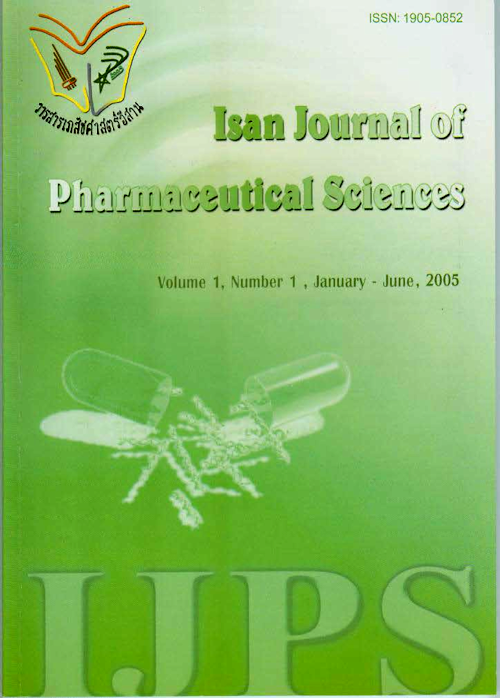Effect of Alginate Film on Release Characteristics of Diclofenac Tablets Prepared using Non-aqueous Binder
Main Article Content
Abstract
This study investigated the cffect of alginate film on the release characteristics of sodium diclofenac tablets prepared using non-aqueous binder. The diclofenac sodium tablets with calcium gluconate were prepared using the wet granulation method and coated with sodium alginate dispersion using a diffusion- controlled interfacial complexation technique, to form insoluble alginate films. Factors affecting the drug content and drug release, such as coating time, concentration of sodium alginate dispersion, and hardcnding, were investigated. The drug content in the coated tablets was not significantly difference to that of the uncoated tablet. The release rate and initial burst release from the coated tablets were statistically lower than those from the core tablets. Both release parameters decreased with increasing coating time and concentration of sodium alginate. Moreover, the hardening process also caused a slower drug release from the coated tablets. This finding indicated that the tablets prepared using non-aqueous binder could be coated with alginate film using diffusion-controlled interfacial complexation technique. The alginate film formed could retard initial burst release and release rate of drug from the tablets.
Article Details
In the case that some parts are used by others The author must Confirm that obtaining permission to use some of the original authors. And must attach evidence That the permission has been included
References
Agrawal, A.M.; Neau, S.H.; Bonate, P.L. Wet granulation fine particle ethylcellulose tablets: effect of production variables and mathematical modelling of drug release. AAPS PharmSci. 2003, 5(2), El3.
Bhagat, H.R.; Mendes, R.W.; Mathiowitz, E.; Bhargava, H.N. A novel, self-correcting membrane coating technique. Pharm. Res. 1991, 8, 576-583.
Bhagat, H.R.; Mendes, R.W.; Mathiowitz, E.; Bhargava, H.N. Kinetics and mechanism of drug release from calcium alginate membrane coted tablets. Drug Dev. Ind. Pharm. 1994, 20. 387-394
Clare, K. Algin. In: Whistler, R.L.; Bemillcr, J.N., editors. Industrial gums: Polysacchrides and their derivatives. 3rd cd. Academic Press: New York. 1993, pp 105-143.
Efcntakis, M.; Buckton. G. The effect of erosion and swelling on the dissolution of theophylline from low and high viscosity sodium alginate matrices. Pharm. Dev. Technol. 2002, 7, 69-77.
Fernandez-Hervas, M.J.; Holgado, M.A.; Fini, A.; Fell, J.T. In vitro evaluation of alginate beads of a diclofenac salt. Int. J. Pharm. 1998, 163, 23-34.
Hwang, S.; Rhee, G.J.; Lee, K.M.; Oh, K.; Kim, c. Release characteristics of ibuprofen from excipient-loaded alginate gel beads. Int. J. Pharm. 1995, 116, 125-128.
Remunan-Lopez, c.; Bodmeier, R. Mechanical, water uptake and permeability properties of crosslinked chitosan glutamate and alginate films. J. Control. Release 1997, 44, 215-225.
Rubio, M.R.; Ghaly, E.s. In vitro release of acetaminophen from sodium alginate controlled release pellets. Drug Dev. Ind. Pharm. 1994. 20, 1239-1251.
Sirkia. T.; Salonen, H.; Vcski, p.; Jurjenson, H.; Marvola, M. Biopharmaceutical evaluation of new prolonged-release press-coated ibuprofen tablets containing sodium alginate to adjust drug release. Int. J. Pharm. 1994, 107. 179-187.
Sriamornsak, S.; Prakongpan, S.; Puttipipatkhachom, S.; Kennedy, R.A. Development of sustained release theophylline pellets coated with calcium pectinate. J. Control. Release 1997a, 47, 221-232.
Sriamornsak, S.; Puttipipatkhachom, S.; Prakongpan, S. Calcium pectinate gel coated pellets as an alternative carrier to calcium pectinate beads. Int. J. Pharm. 1997b, 156, 189-194.
Wade, A.; Weller, P.J. Handbook of pharmaceutical excipients. 2nd ed. The Pharmaceutical Press: London, 1994, pp 428-430.


